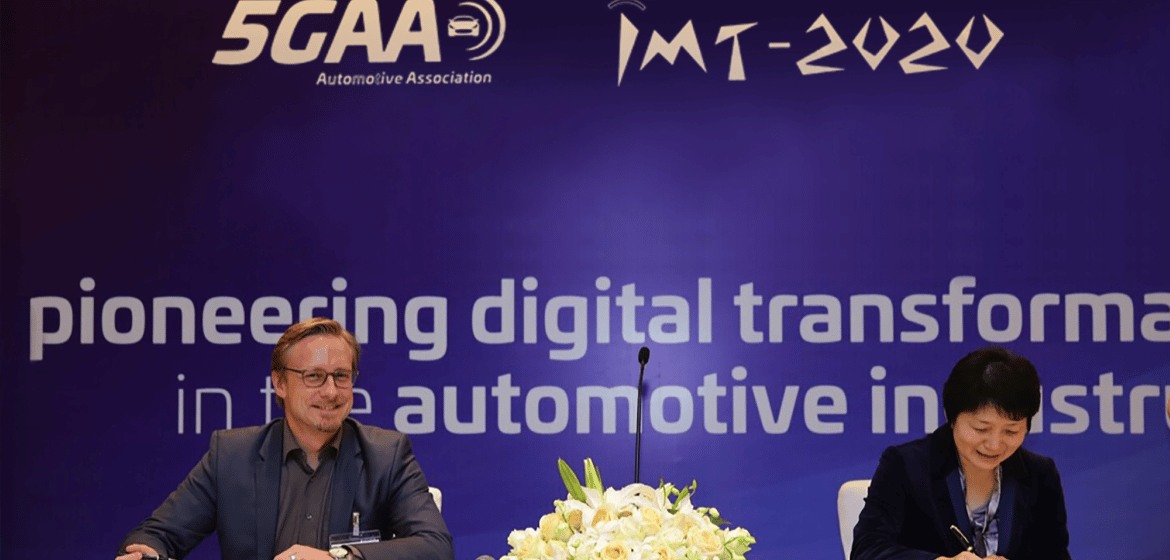
Co-operating to build a better Mobility Ecosystem: 5GAA and IMT2020 Present their Partnership
The 5G Automotive Association (5GAA) is delighted to announce that it is embarking on a new partnership with the IMT-2020 (5G) Promotion Group.
On 16 November 2017, in Shanghai, both parties have signed a Memorandum of Understanding in order to foster cooperation in the field of connected and autonomous driving solutions. This exciting journey of collaboration will also be a unique opportunity to pool resources in technology research and related use cases on a global scale.
Both organisations are advocates for the accelerated development of enhanced mobile communication systems between all road users and vehicles. The focus technologies for both associations are LTE-V2X and 5G-V2X. The 5GAA and IMT-2020 (5G) Promotion Group will harness their joint expertise on a range of projects, such as:
- Further conducting technical research on LTE-V2X and 5G-V2X
- Ensuring the promotion of the applications of 5G based V2X solutions
Since its launch in September 2016, 5GAA has grown exponentially worldwide. Over 60 industry leaders from the automotive, technology and telecommunications industries have teamed up to accelerate C-V2X technology development and its evolution to 5G-V2X for enhanced safety, automated driving and connected mobility. Together, 5GAA members are building a safer, more sustainable and connected transport ecosystem.
The Chairman of 5GAA, Christoph Voigt, is confident that both organisations’ hold a bright future of collaboration together: “5GAA was created to connect the telecom industry and vehicle manufacturers to develop 360-degree solutions for safer and more sustainable mobility systems. We look forward to working with IMT-2020 to define the requirements of C-V2X and to create a successful V2X ecosystem”.
IMT-2020 was established in February 2013. It is the major platform for 5G technology innovation, industry promotion and international cooperation in China. IMT-2020 C-V2X Working Group is established by IMT-2020 Expert Committee in April 2017, who conduct technical research on LTE-V2X and 5G-V2X innovation. Its members include leading operators, vendors, universities and research institutes in the telecommunication and automotive industries.
Wang Zhiqin, Chairman of IMT-2020 welcomed the signature of the Memorandum of Understanding between both organisations: ”IMT-2020 is the major platform for 5G technology innovation, industry promotion and international cooperation in China, and IMT-2020 C-V2X Working Group is responsible for industry integration among ICT, automobile, transportation and etc.. IMT-2020 and 5GAA have a number of partners and working interests in common, we are glad to cooperate with 5GAA together to ensure the successful development and commercialization of C-V2X and future 5G automotive services”.

Bright Regulatory Trends of C-V2X in Asia Pacific Region
Shanghai, China – On 16 November, The 5G Automotive Association (5GAA) hosted its Second General Assembly. Following announcements of the association’s progress and growth worldwide, 5GAA inaugurated the Asia Pacific Roundtable. Here, regulators from China and South Korea joined the discussion, sharing industry trends for the Internet of Vehicles and future Intelligent Transport Systems, as well as a number of real-life demonstrations of technology that is being developed in this region.
5GAA is a unique organisation on the global stage: with leading members of the automotive and telecommunications industry as founders. The association aims to pioneer digital transformation on our roads, creating a safer and more sustainable road environment for all.
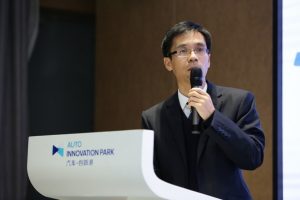
At the Asia Pacific Roundtable, Mr. He Guangjin from the Chinese TMRI (Traffic Management Research Institution) of MPS (Ministry of Public Security), presented the demonstration made at WIOT 2017 (World Internet of Things Expo) in Wuxi. This was the first demonstration from the Chinese public security industry where the LTE-V2X technology was employed. Additionally, it was so a premiere for the official traffic management system to be opened to vehicles on open roads. TMR also announced its plan to build a larger LTE-V2X pre-commercial trial including 20 to 50 intersections in 2018, to verify the broadcasting of real-time traffic conditions of intersections and the reception of information transmitted from vehicles. Additionally, TMRI is actively working on industry and national standards such as “Road Traffic Signal Controller I2V Information Distribution Interface Specifications”, “Adaptive Verification Management Regulation of Intelligent & Connected Vehicles (ICV) on Public Roads”, etc.

Dr. Cen Yanqing from the Chinese RIOH (Research Institution of Highway) of the MOT (Ministry of Transport) shared the important progress of the MOT. The ministry is paying close attention to automated driving and has already set up a dedicated working group to coordinate the corresponding ministries and guide the work on automated driving technology. In order to achieve automated driving, it is not sufficient to equip autonomous vehicles but it’s also needed to have an intelligent reformation of the road infrastructure and vehicle-to-road, vehicle-to-vehicle, vehicle-to-person communication and interaction in an effective way. To further promote the automated driving, the Ministry of Transport has built test zone for commercial vehicles verification in Tongzhou, Beijing, including specific scenarios e.g. ramps, intersections, and traffic lights.
When Dr. Cen was asked about whether MOT will mandate any technical specifications, he clarified there is no mandatory regulation so far. The MOT – as a department which uses technology – is opened to the utilisation of the V2X technology, but will select the best and most efficient technology eventually, he said. He also claimed that the MOT would support some of the Chinese telecommunication corporate contributions such as CMCC, Huawei, and Datang. Finally, he declared “we cannot implement two technologies but only one”.
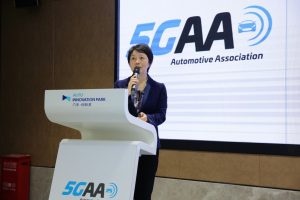
•Vice President of the China Academy of Information and Communications Technology, Ministry of Industry and Information Technology, China
•Chairman of the IMT-2020 (5G) Promotion Group
Ms. Wang Zhiqin, from CAICT (China Academy of Information and Communications Technology) of MIIT(Ministry of Industry and Information Technology), explained that the national CAV (Connected and Automated Vehicles) industry development committee advises to promote the LTE-V2X technology deployment and application, and its evolution to 5G and internet of vehicles integration development. He also announced the release of the Guide to the Construction of Standard Architecture for CAV Industry Development jointly developed by MIIT and NSC (National Standardization Administration), in which the LTE-V2X and 5G technologies are greatly highlighted in the information and communications volume. When asked about the spectrum of the Internet of Vehicles in China, Ms. Wang expressed that the government attaches great importance to it and needs prompt issuance and release of a positive guidance to the industry. She believes China should release this C-V2X spectrum relatively soon.
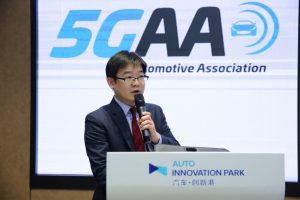
Deputy Director, ITS and Road Safety Division, Road Bureau, Ministry of Land, Infrastructure and Transport, South Korea
Mr. Chang-ki Kim, from the MOLIT (Ministry of Land, Infrastructure, and Transport) explained that his division in Korea is implementing two strategies to promote the commercialisation of Internet of Vehicles. The first strategy consists of focusing on the C-ITS safety aspect by developing and commercialising the RoDAS (Road Driving Assistant Systems) by 2020 in accordance with the National ITS Master Plan. As CAV (Connected and Automated Vehicles) will improve road safety issues under the mixed condition of AV (Automated Vehicles) and LV (Legacy Vehicles) in both highway and urban areas. MOLIT will launch, as its second strategy, the transportation renovation program by promoting and integrating the C-ITS and CAV technologies under their CAD (Connected and Automated Driving) Test-beds. Additionally, he emphasised that deploying those Test-beds in Korea would include the verification of various communication techniques, e.g., C-V2X (LTE, 5G), under the real and dynamic road environment. Mr. Kim expressed his intention to invite all ICT and CAD testing companies to conduct their service applications and to develop their cooperation and sharing models by joining those Test-beds.

5GAA participates in Testbed Visit in Shanghai
Shanghai, China – 16 November 2017 – following the 5G Automotive Association General Assembly Meeting, 5GAA leadership, delegates as well as representatives from Chinese and South Korean government participated in a testbed visit. This practice case was then followed by eight use-cases, demonstrating the success of the LTE-V2X advances. Both of these actions took place at the purpose-built Shanghai district – Testbed F-zone and T-Zone – where the latest developments in vehicle technology are assessed.
1. Realizing LTE-V2X’s capacity: Visit to F-Zone
Huawei LTE-V leader for Research & Development, Mr. Yangyongchao, opened the visit by showcasing LTE-V2X testing reports as well as running a live test result. This series of LTE-V2X performance tests were measured in terms of the technology’s capacity to manage two variables (link level and system level). This analysis was managed by the partnership of China Mobile (CMCC), SIAC and SAIC Motor.
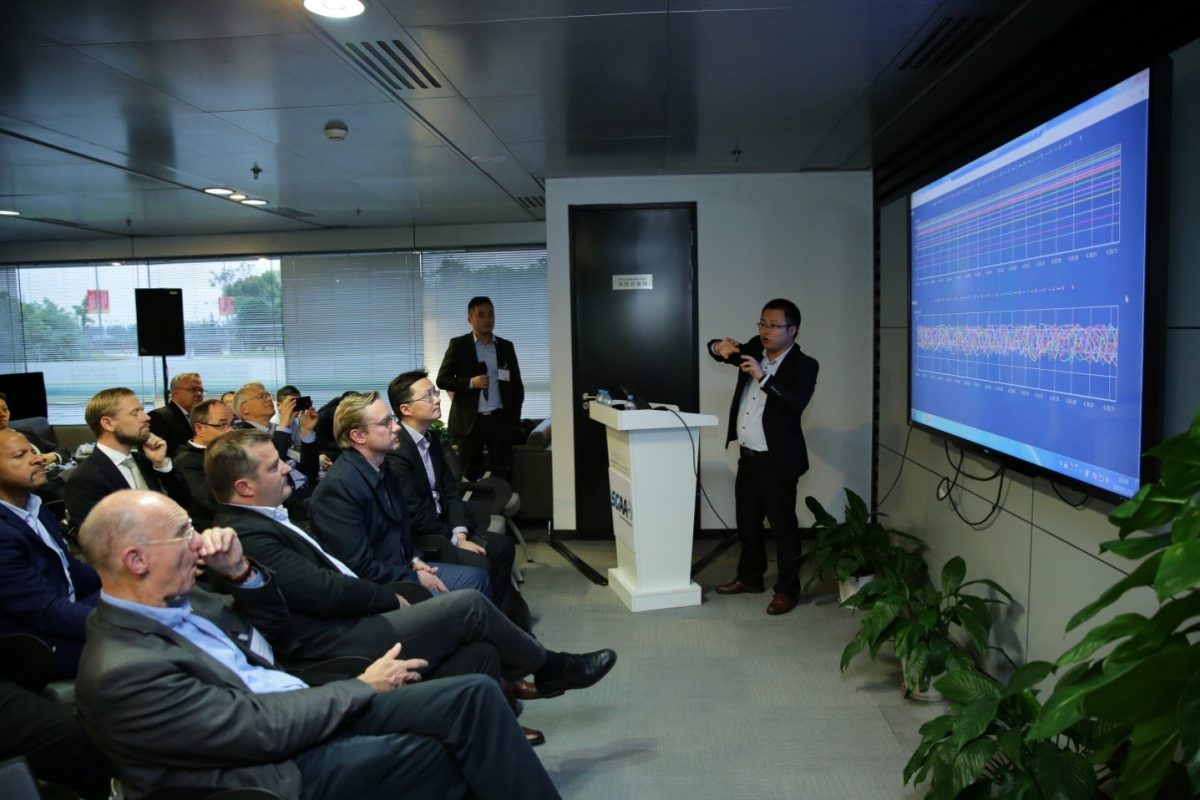
- Link Level Testing: LTE-V2X can support relative vehicle speeds of up to 500km/h, even with correction for timing and frequency errors. LTE-V2X shows excellent link performance with different packet size. The maximum RSU coverage range reaches more than 1km from the test vehicle.
- System Level Testing: 400 vehicles were analysed in this trial environment. Based on this, the capacity and of Vehicle-to-Vehicle and Vehicle- to-Infrastructure is smaller is functional in a range of 20 metres. Messages were transmitted at a success rate of 90% within the demanded communication range in high-density scenarios.
Right after this presentation, SIAC led the delegates to visit the site of F-Zone. Mr. Lilin, director of SIAC explained that F-zone is an enclosed area conducting different scenarios such as parks, urban roads with intersections, simulated highway and related road facilities. Additionally, F-zone is the national level Intelligent and Connected Vehicles test zone equipped with background vehicles, positioning capability and telecommunication infrastructure, including LTE-V2X based RSU, base stations that support both LTE and LTE-V2X, and assisted by operation system.

2. T-Zone visit
After the inspection of F-Zone, delegates visited C-V2X demonstration in T-Zone and observed eight cases in SAIC Motor’s intelligent connected vehicle operated with China Mobile and Huawei. The technology showcased was powered by 5G-V2X. This opened the vehicle up to possibilities such as Tele-Operated Driving, LTE-V2X based Platooning, Forward collision warning, Traffic light speed advisory and Vulnerable Road user warning. Dr. Liu Fen, also explained that with the abundant communications environment in T-zone and more C-V2X functionality can be realised in the future.
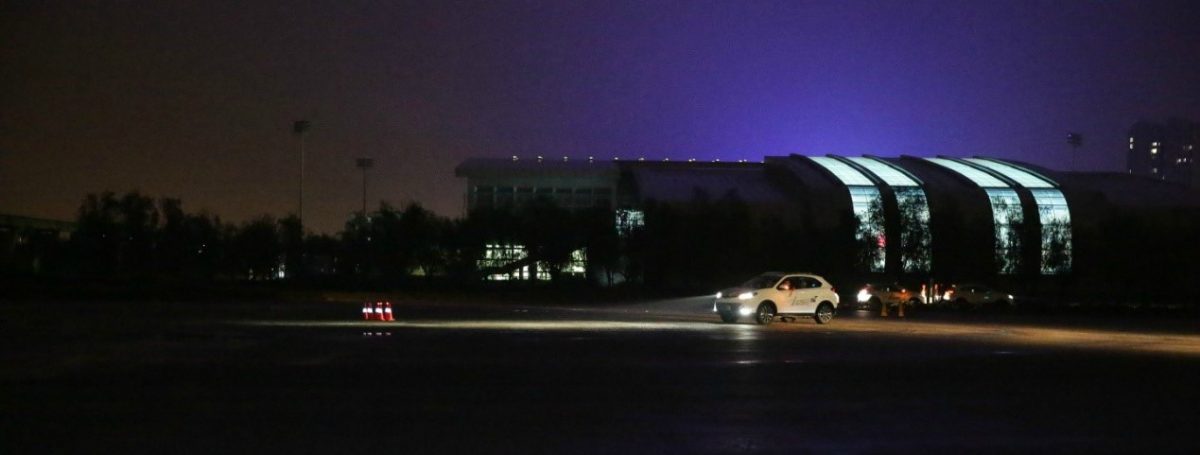
Christoph Voigt, Chairman of 5GAA, views these advances with optimism: “Today’s opportunity to see the fantastic progress from SIAC, SAIC Motor, China Mobile and Huawei is a demonstration of the unlimited possibilities that investing in 5G and LTE -V2X technologies hold. We know that C-V2X technology has the capacity for high-speed, high-density communication between vehicles, infrastructure, and pedestrians. Following further research and collaboration with our members and policy makers in governments around the world, 5GAA is looking forward to introducing this technology globally.”
Dino Flore, Director General of 5GAA is proud of the extensive partnerships that the association has fostered: “5GAA’s aim is to act as a bridge between the automotive and telecommunications industries. I would like to thank our hosts today in Shanghai for their hospitality and proudly showcasing the possibilities promised by C-V2X and 5G. Our organisation is focused on accelerating research and delivering solutions to society to build safer and more sustainable transport for our citizens. Today’s demonstrations are proof of what future holds.”
About the 5GAA
The 5G Automotive Association (5GAA) is a global cross-industry organisation of companies from the automotive, technology and telecommunications industries (ICT), working together to develop end-to-end solutions for future mobility and transportation services. Created in 2016, the Association is comprised of over 67 members which mission is to develop, test and promote communications solutions, initiate their standardization and accelerate their commercial availability and global market penetration to address societal need.

5GAA Launches its Second General Assembly and Working Group Meeting in Shanghai
From 13-17 November 2017, the global members and invited guests of the 5G Automotive Association will assemble in Shanghai, China. The aim of the meeting is to promote the advancement of our mobility ecosystem as well as deepening the association’s collaboration with the Chinese automotive and telecommunications industries.
Over the course of the first three days (13-15 November 2017), 5GAA’s members will collaborate in Working Group meetings. This is a unique opportunity for global leaders in the automotive and telecommunications industries to share innovative practices and drive towards progress.
On the 16th November, The General Assembly will take place: a 1-day meeting where the association’s members will reflect on 2017’s achievements as well as outlining a vision for 2018.
5GAA is honoured to welcome illustrious representatives from Public Institutes to participate in the Asia Pacific Roundtable discussion on Thursday, 16 November 2017. The delegation will include Chinese representatives from the Traffic Management Research Institute of Ministry of Public Security, the Research Institute of Highway Ministry of Transport, the China Academy of Information and Communications Technology of Ministry of Industry and Information Technology, and the Road Bureau of Ministry of Land, Infrastructure, and Transport.
Additionally, South Korean delegates from the Road Bureau of Ministry of Land, Infrastructure, and Transport will participate. This Roundtable promises to generate interesting ideas.
Following the Roundtable discussion and in order to gain a greater practical understanding of the transportation advances in China, 5GAA will visit the Shanghai Testbed with a live demonstration of the power of LTE-V2X and 5G-V2X technology in transport.
Chairman of 5GAA, Christoph Voigt, underlines the importance of choosing China as the location for the Second General Assembly: “We are looking forward to further understanding the progress China can offer to advance 5G transport solutions globally. China is a strong supporter of deepening 5G connectivity to deliver safety and sustainability solutions on our roads. Our discussions with representatives from political and academic institutions in China will offer us an opportunity to gain support around the World and to innovate further, faster and more effectively.”
Since its launch in September 2016, 5GAA has grown exponentially worldwide. Over 60 industry leaders from the automotive, technology and telecommunications industries have teamed up to accelerate C-V2X technology development and its evolution to 5G-V2X for enhanced safety, automated driving, and connected mobility. Together, 5GAA members are building a safer, more sustainable and connected transport ecosystem.
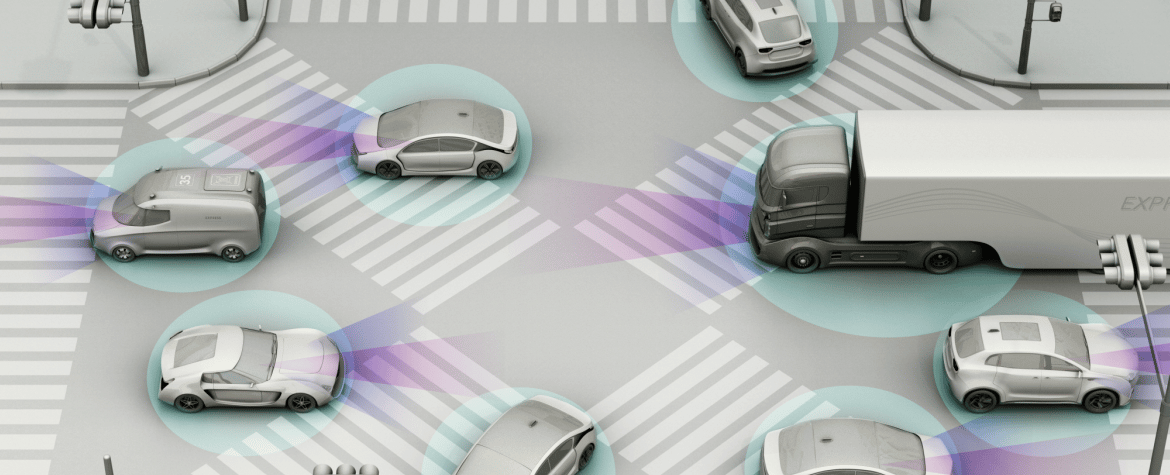
5GAA: cellular technology is key enabler for smart mobility of the future
Industry association calls on European Commission to allow stakeholders to work collaboratively towards an agreement on the technology catalyzing the mobility of the future and warns against a “premature and cumbersome legislative decision”.
The 5G Automotive Association (5GAA) encourages the automotive, technology, and telecommunications industries and the European Commission to be ambitious when evaluating technologies for connected, autonomous vehicles. 5GAA is confident that cellular communication technology (C-V2X) has the most benefits when applied to connected, self-driving cars. It has provided its views to the Commission in a workshop and a letter with recommendations. Since its launch one year ago, over 50 industry leaders from the automotive, technology and telecommunications industries have teamed up in 5GAA to accelerate C-V2X technology development and its evolution to 5G-V2X for enhanced safety, automated driving and connected mobility.
Christoph Voigt, Chairman of 5GAA said, “5GAA is confident that cellular technology (including direct vehicle-to-vehicle communication at 5.9 GHz) has the potential to lead to the best outcomes in the long run. We are strongly relying on the European institutional support to put in place a regulatory framework allowing for an industry-driven and swift deployment of this technology. It is crucial to consider how the 5.9 GHz band, the “life blood” of wireless vehicle communication, can be used efficiently in the context of 5G technology evolution, road safety, and economic scalability. The automotive and transportation sectors, both public and private, are making significant investment commitments. Therefore, we are urging the European Commission to allow the ITS-G5 and C-V2X stakeholders to work together towards an agreement on the future of connected and automated cars, without a premature and cumbersome legislative decision.”
5GAA has recently provided its views to the Commission in a workshop and a letter with recommendations.
Christoph Voigt: “We should aim high enough when selecting the solutions to make connected, self-driving vehicles a reality. These are a catalyst to improving the quality of life globally through safer traffic, improved mobility, cleaner air in cities, and a better experience overall for drivers.”
Dino Flore, Director General of 5GAA adds, “Saving lives through improved road safety is obviously the primary positive outcome of deploying communication technology solutions. In addition, we should take into account other aspects when evaluating alternatives. We’re not only talking about reducing congestion and pollution but also optimizing the driving experience. It is our view that cellular technology, including direct vehicle-to-vehicle communication at 5.9 GHz, has the most upward potential in the long run.”
Helping vehicles “understand the environment they are navigating”
Launched in September 2016 by 8 founding members the 5GAA has in less than a year grown to include over 50 leaders from the automotive, technology and telecom industries who collaborate cross-industry on the future of transport. 5GAA’s mission is to develop, test, and promote communications solutions, initiate their standardization and accelerate their commercial availability and global market penetration. The objective is to address society’s connected mobility and road safety needs with applications such as autonomous driving, ubiquitous access to services and integration into smart city and intelligent transportation.
Connected vehicles use communication technology to not only communicate with other vehicles but also with road infrastructure, other road users such as pedestrians, and the Internet – e.g. to provide traffic updates and parking guidance. Use cases include collision warnings, “traffic jam ahead” warnings, green light optimal speed advisory, parking guidance, and assisting drivers in tackling treacherous traffic situations (e.g. turning left at a crossroads). Connected vehicles will eventually reduce pollution, and make traffic more efficient, reducing congestion in cities and improving the flow of goods and people.
Christoph Voigt explains, “Equipping cars with sensors and cameras is one thing, but imagine what is possible when cars use cellular technology to communicate with their entire ecosystem: other vehicles, road users, infrastructure, and central services that give real-time information.”
“It’s the difference between a car that is capable of seeing what is happening in its immediate surroundings and one that can use all available information to allow for a safer and more comfortable driving experience. After all, as drivers we do more than purely react to what’s in front of us. We listen to traffic info, we are aware of the area we’re navigating, and we are alert to traffic jams in rush hour. We use context to guide our driving.”
“This is exactly what cellular connectivity can enable vehicles to make easier, or even take over from us in the case of self-driving vehicles. Except that it will be faster and more accurate,” concludes Christoph Voigt.
-Ends
About 5GAA
The 5G Automotive Association (5GAA) is a global cross-industry organisation of companies from the automotive, technology and telecommunications industries (ICT), working together to develop end-to-end solutions for future mobility and transportation services. Created in 2016, the Association is comprised of over 50 members which mission
is to develop, test and promote communications solutions, initiate their standardization and accelerate their commercial availability and global market penetration to address societal need. For more information please visit 5gaa.org
Contacts
Robbe Libbrecht
FINN PR
robbe.libbrecht@finnpr.com
M +32 497 23 30 38
5GAA Marketing & Communications
marcom@5GAA.org

5GAA & GSMA Letter to EU Commission
The 5G Automotive Association (5GAA) represents the automotive and telecom industry’s alignment for the global connected and autonomous vehicle, supported by more than 50 member companies including many world class car manufacturers. 5GAA’s mission is to develop, test and promote communication solutions for the future of the 5G automotive economy in Europe and globally. The 5GAA is actively contributing to ETSI, 3GPP and ITU in the fields of standardisation and spectrum-related matters. The 5GAA is committed to accelerating Cellular-V2X (C-V2X) standards seamlessly embracing 4G and 5G, and would like to call on the European Commission to support stakeholders in this collaborative process by providing leadership and timely regulatory support.
The GSMA, which represents the Mobile Network Operators globally, has succeddfully collaborated with the Automotive Industry for many years. Together we have created secure solutions that have advanced the Connected Car market with major benefits to consumers. Cellular V2X will enable further cross-industry collaboration with government agencies in cities and transport. The GSMA believes that C-V2X will contribute to safer vehicles, reduce congestion and pollution. It will build upon the existing 23 million existing Cellular Connected Car market in Europe and drive the deployment of Digital Europe.
The 5GAA is keenly aware of the imperative for road safety and the need for Europe to assert 5G leadership while ensuring spectrum efficiency. Given the longevity of vehicles and the significant industry investment in cellular technologies, C-V2X will be of utmost importance as Europe and the world transitions to 5G in supporting mission critical applications and the massive opportunities associated with the introduction of a new global standard.
We therefore urge the European Commission to allow the ITS-G5 and C-V2X stakeholders to work collaboratively toward an agreement on the future of connected and automated cars, without a premature and cumbersome legislative decision.
The 5GAA is confident that the industry will ultimately align with a pragmatic solution that saves the most lives while embracing technology evolution, and managing complexity and cost. We firmly believe in and pledge to collaboratively work with other stakeholders on solutions that ultimately benefit the European Union. We encourage the European Commission to support technology neutrality, mitigating a significant risk that 5G in the key automotive vertical will struggle, thus impacting the European automotive industry and the future growth and global competitiveness of the EU economy.
Europe is an important pillar for members of the 5GAA and is leading the world in the development of smart transportation solutions. A considerable part of C-V2X innovation occurs in Europe, and will contribute to road safety, the development of smart cities and trans-border corridors, to achieve the efficiency and environmental objectives that ultimately benefit European citizens. 5GAA members are accelerating C-V2X with pre-commercial trials in Europe, and will culminate in global deployments.
We are strongly supportive of 3GPP technologies for direct communications over ITS spectrum to enable vehicle-to-vehicle, vehicle-to-infrastructure, vehicle-to-pedestrian (and other vulnerable road users), i.e. C-V2X, while also leveraging vehicle-to-network over mobile operator spectrum. An important part of the ongoing 5GAA work is to support the European Commission’s policies laid out in the C-ITS Masterplan, as well as Gear2030 for Highly Automated Vehicles and the 5G Action Plan. We strongly rely on the European institutional support to enable a regulatory framework conducive to an industry-driven and swift deployment of the platform of their choice.
The 5GAA looks forward to continuing the dialogue with the European Commission and the various industry stakeholders in order to lay the foundation for a 5G automotive future in Europe.
Download the letter here

Demonstration of C-V2X Direct Communication Interoperability
On July 2017 at the UTAC CERAM proving grounds in Paris, France the 5G Automotive Association and its members BMW Group, Groupe PSA, Ford Motor Company, Qualcomm Technologies and Savari showcased multiple automakers interoperating with C-V2X direct communications between passenger cars, motorcycles, pedestrians and traffic signals, without any cellular network involvement.
Discover the highlights of the demonstration on C-V2X Direct Communication Interoperability in the video below.
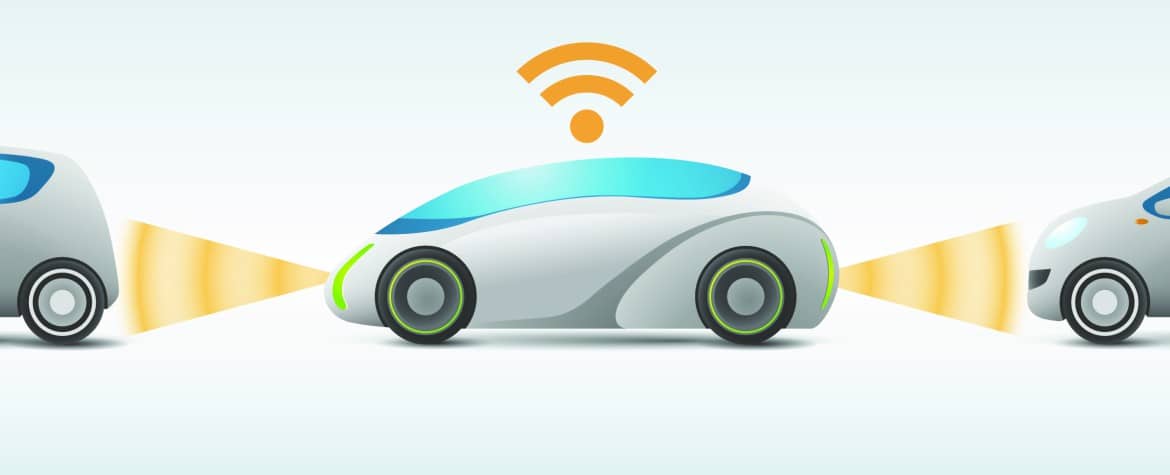
Coexistence of C-V2X and 802.11p at 5.9 GHz
Today the European market has interest in two distinct technologies for Intelligent Transport Systems (ITS) and the provision of vehicle to vehicle communications; namely 3GPP LTE-V2X and IEEE 802.11p.
The technology-neutral nature of spectrum regulations in Europe means that both LTE-V2X1 and 802.11p have equal rights to operate in the 5.9 GHz band, subject to compliance with the relevant regulatory technical conditions.
It is not the objective of this paper to compare and contrast the relative merits of these two technologies, although the 5GAA is a proponent of LTE-V2X as today’s realisation of Cellular V2X (C-V2X), and as a platform to evolve towards 5G technologies.
Instead, in this paper, we address the issue of co-channel coexistence between the two technologies at 5.9 GHz. We note that this is a critically important issue for the ITS industry, and that it is beneficial for all stakeholders to arrive at a proportionate, fair, and pragmatic solution to resolve this matter, and allow the market to proceed with the deployment of ITS equipment.
To this end, we propose a solution – to be agreed among the stakeholders – to be implemented in up to three steps. In all steps, each of C-V2X and 802.11p can operate safety-related ITS services free from co-channel interference from the other technology. The difference between the distinct steps lies in the overall usage efficiency of the spectrum resource: In the short-term, we propose to allocate distinct 10 MHz channels at 5875-5905 MHz to each of the two technologies, while the final configuration will apply full sharing of all available channels across the two technologies. The latter will require further studies on appropriate sharing mechanisms and thus cannot be provided from the beginning.
We further explain how such a first step partitioning of 5875-5905 MHz might be complemented by additional technical mechanisms which would – where needed – allow each of C-V2X and 802.11p to access the remaining 20 MHz in a fair manner, with a reduced risk of harmful co-channel interference.
We believe that the proposed approach would greatly facilitate the coexistence of C-V2X and 802.11p at 5.9 GHz, and we would encourage stakeholders to further develop this proposal and come to a speedy agreement on this for the benefit of the European ITS industry as a whole.
Read the full paper here.

5GAA welcomes AT&T, Jaguar Land Rover, NTT DOCOMO and Samsung Electronics as elected Board members
The 5G Automotive Association announced today the election of its new Board members following the General Assembly held on May 11, 2017. Continuing members AUDI AG, BMW Group, China Mobile, Daimler AG, Ericsson, Ford, Huawei, Intel, Nokia, SAIC Motor, Vodafone Group and Qualcomm Incorporated will be joined by AT&T, Jaguar Land Rover, NTT DOCOMO and Samsung Electronics.
The election of AT&T, Jaguar Land Rover, NTT DOCOMO and Samsung Electronics as Board members will strengthen the position of 5GAA as a global, cross-industry association of automotive, technology and telecommunications companies. It reflects the diversity of 5GAA’s membership, both in terms of geographical spread and expertise.
The Chairperson is Christoph Voigt (Audi) and the Vice Chairperson is Thierry Klein (Nokia), both elected to their second term. The Board of the Association renewed the mandate of the outgoing Executive Committee: Dino Flore (Qualcomm) will continue to serve as Director General, Markus Dillinger (Huawei) as Secretary, and Fathi Arafat Husein El-Dwaik (BMW) as Treasurer. The Board also confirmed the appointment of elected Working Groups Chairs and Vice-Chairs.
“We are very pleased that AT&T, Jaguar Land Rover, NTT DOCOMO and Samsung Electronics have joined the 5GAA Board,” said Christoph Voigt, Chairman of the 5GAA Board. “With their global footprint and diverse expertise, they will contribute to further connect communication and the automotive industry to develop end-to-end solutions for future mobility and transportation services.”
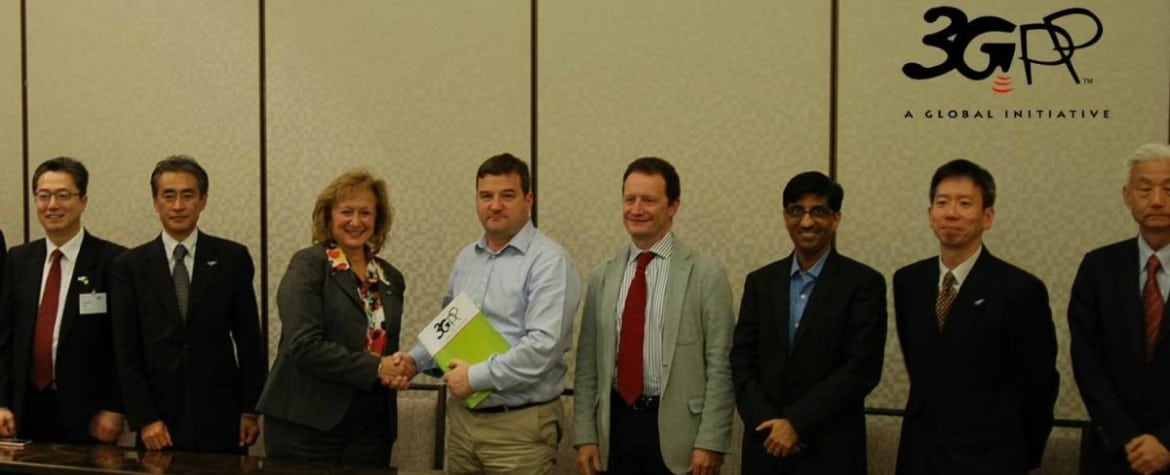
5GAA joins 3GPP
The 5G Automotive Association has become a Market Representation Partner (MRP) in 3GPP, bringing in the influence and expertise of vehicle manufacturers and a variety of important companies from the automotive sector, to the 3GPP environment. Dino Flore, Director General of 5GAA, was present at the 3GPP Organizational Partner’s meeting in West Palm Beach on April 26, to complete the signing of the Partnership Agreement.
The 5GAA application for 3GPP MRP status stated “It is important to connect the telecom industry and vehicle manufacturers, to develop end-to-end solutions for future mobility and transportation services” Dino Flore told the 3GPP OP meeting “The access part is vitally important and we will work on that with 3GPP. In addition to that, we will look at the other pieces required – including the work on upper layers (SDOs including ETSI-ITS, ISO, SAE and IEEE) and security aspects – to develop the system as a whole.”
The work is ongoing in 3GPP, with an initial version of the V2X access specifications in Release 14 and active discussions to define next generation V2X capabilities on-going. Susan Miller (3GPP OP Chair, ATIS President and CEO) welcomed 5GAA as a partner and noted the positive effect that Dino Flore’s vast experience in the 3GPP leadership, most recently as the RAN Chairman, will have for the successful integration of the 5GAA into the 3GPP family. Ms. Miller said “5GAA is bringing in the needs of a key vertical at an important time for the project.”
“5G will be much more than mobile broadband connectivity, it will cover a variety of use-cases and industries” Dino Flore, DG 5GAA.


